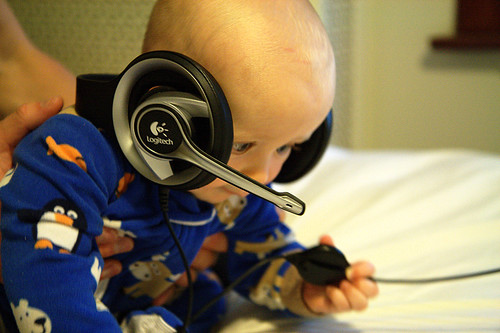Many web meetings and webinars are spoiled by poor sound quality. The volume level fluctuates, background noise interferes and the sound quality varies. Often this is due to the unstable nature of wireless connections, but generally the problem is caused by headsets or the lack of them. A post by Ken Molay on his Webinar Blog, The Perfect Webcam Headset Doesn't Exist, outlines the main problems. The in-built microphones can offer good sound quality (I've heard some good examples of this) but more often than not they offer a metallic sound and require the speaker to speak directly into the laptop without moving around. Another drawback of the in-built microphone is that if you try to type it sounds like an elephant practicing tap-dancing. I often use a desktop microphone (Jabra Speak) and this offers very good quality but not if you move around a lot or start typing of doing anything on the actual desktop. The in-built microphones in webcams are usually the worst possible choice, though in my experience the computer often chooses this as the default microphone so it's a good idea to always check before starting a web meeting.
Bluetooth earpieces with microphone would seem an ideal option but there are drawbacks even here.
Wireless devices lose power, lose pairing, and catch interference from other signals. Bluetooth is susceptible to transmission lag that can mess up audio/video synchronization or make smooth two-way conversation difficult.
So the best option seems to be the good old wired headset, preferably with a USB connection.
A headset is the optimal way to get near-field clarity and consistent volume, since it stays in place at the same distance from the mouth no matter what the presenter does.
The trouble is that headsets aren't particularly flattering fashion accessories and are not particularly comfortable either. I use a big clunky Logitech headset that works well but it would be nice to have something less conspicuous. Most people would rather not use one at all and this is evident in many meetings and webinars I am involved in. Ken Molay concludes that there is still no headset that ticks all the boxes: light, comfortable and almost invisible. The best bet is the ultra thin boom microphones often used by conference speakers but no manufacturer has produced one with an earpiece speaker. Ken offers a nice specification for manufacturers to deliver. I hope it comes along soon for the sake of better web communication.
My ideal, "optimal" headset for use while on a video webcast would be a thin whip boom earhook microphone, connected to the USB port of my computer, with an integrated low-profile earpiece. The whole thing should be available in two or three colors to get closer to a range of human skin tones. It needs a minimum six-foot (two-meter) cable. And it should be optimized for USB low-power operating voltage and human speech frequency range.


